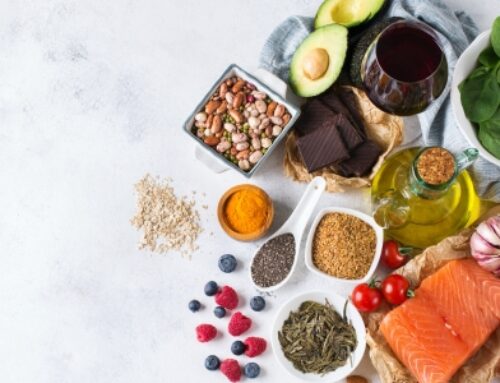What is cholesterol and how does it affect my health?
Cholesterol is essential to our body. It is produced by our liver and is involved in many of the body’s metabolic processes, such as the production of hormones, vitamin D and bile for the digestion of fat.
We know that high levels of cholesterol in our blood, particularly certain types of cholesterol, can increase our risk of developing heart disease. We also know that our diet can affect the types and volume of cholesterol that our liver produces. By making the right choices in our diet we are able to optimise our cholesterol levels.
Here are 10 of the best ways to improve your cholesterol levels:
1. Eat a rainbow of fruits and vegetables.
Fruits and vegetables are full of soluble fibre. Studies have shown that soluble fibre is helpful in lowering unhealthy cholesterol levels, as it hinders the body’s ability to absorb cholesterol from foods. The more vegetables you include in your meal, the better. I love veggies and I always like to prepare them in a colourful, fun way!
There are so many different ways to combine and flavour the vegetables in your meals. Below are some of my personal favourites:
- A salad with seasonal fruits, nuts and seeds.
- Raw vegetables and dips.
- Bake a tray of pumpkin, zucchini, potato, tomato, mushroom and onion rings.
- A pot of mixed vegetable soup with beans, and a dash of olive oil.
- Stir-fry vegetables with brown rice.
Recipes to try:
Toasted Chicken and Vegetable Salad
Zesty Lamb and Grilled Vegetables
2. Go for wholegrains.
Grains include oats, wheat, barley, rye, corn, rice and quinoa. They are the excellent source of soluble fibre, which helps to lower our unhealthy cholesterol in blood.
Grains are considered as wholegrains when they are minimally processed. This means that they have changed very little between the farm and your plate. The more husk and roughage, the better! Swapping to wholegrain food varieties is one the easiest ways to boost your intake of soluble fibre!
- Breakfast: Swap your cereal to high fibre varieties. Look for the word “whole” or “wholegrain” as the 1st or 2nd listed on the ingredient list.
- Lunch: Swap white sandwich bread to wholegrain/wholemeal alternatives.
- Snack: Swap regular crackers to the wholegrain varieties.
- Dinner: Have brown rice instead of white rice or cook with wholemeal or high fibre pasta.
It can be really easy swapping for wholegrains. I find these wholegrain foods fill me up longer and keep me fuller with the extra fibre, vitamins and minerals.
3. Eat your meat and poultry wisely.
It’s been well researched that a diet high in saturated fat can raise unhealthy cholesterol in the blood. Typical sources of saturated fat come from animal products, such as red meat, poultry, fullcream dairy products, and vegetable oils made from tropical fruit like coconut and palm oil. Making healthier meat choices can help to lower unhealthy cholesterol.
Here are some tips I‘ve learnt to reduce saturated fat intake:
Buy a leaner cut of meat: as a general rule, the more white spots you can see on meat, the more saturated fat it contains
- Beef: Tenderloin steak, filet mignon, topside silverside, and leaner beef mince.
- Pork: Tenderloin pork, loin chop cuts, pork steaks, and leaner pork mince.
- Lamb: Loin, shank and leg.
- Chicken: Chicken breast, leaner chicken mince.
- Try to avoid buying pre-made sausages, salami, and meat patties as they are generally high in saturated fat and salt.
Cut down on fat when cooking meat.
- Trim off any visible fat and skin before cooking. The skin is much higher in fat than the meat itself.
- Try to avoid deep frying or adding too much oil when stir-frying. Or, try baking, grilling, barbecuing, or stewing your meat.
Recipes to try:
Low GI, Low GL, Spaghetti Bolognese
4. Go light for dairy.
Dairy foods are good sources of Calcium, vitamin D, protein, and other essential nutrients. However, for those who are trying to improve cholesterol levels, full-fat dairy may not be the best option. Let’s explore the different types of dairy that we normally see.
Milk: Full cream milk has had none of the natural cream removed, and is characterised by a rich and creamy texture. Most brands contain about 3.4% saturated fat. This is not a lot of fat, however if you consume large volumes of milk, swapping to a light or skim milk can reduce your overall saturated fat intake.
Cheese: Not only does cheese taste good, but it also contains a concentrated source of nutrients. In fact, the rich and creamy taste that you like is mainly from the high fat in cheese, saturated fat in particular. So, I‘ve come up with some general ideas that you can follow for making healthier choices:
As a general rule, soft cheeses are lower in fat, and hard cheeses are higher in fat. Some examples of high-fat cheeses are: blue cheese, brie, cheddar, camembert and cream cheese.
It is advised best to choose from:
- Any kind of reduced fat cheese.
- Ricotta.
- Cottage cheese.
- Goat’s cheese.
- Feta cheese.
If you can’t decide which is the healthier choice among those products, use per 100g column on the nutrition label and compare the saturated fat between the above products and choose the lowest saturated fat option.
Butter vs margarine: When we walk down the butter and margarine aisle, we often get confused whether we should get butter or margarine. The correct way to look at it is through their nutritional composition. Butter is regarded as a less healthier choice due to its high saturated fat. In comparison, margarine is a healthier choice because its fat is made up of polyunsaturated and monounsaturated fat, which help to increase healthy cholesterol.
5. Magic Beans (and legumes).
Legumes are an especially good source of soluble fibre and can help to improve cholesterol levels. Legumes like chickpeas, kidney beans, black beans, butter beans and lentils are all great foods which you can add to your meal.
Adding legumes to your diet can be so easy! Try these mix-and-match options:
- Spread sandwiches or crackers with hummus.
- Try baked beans on toast, or add them to an omelette.
- Add beans and legumes to tacos, burritos, spaghetti dishes, and stews.
- Toss lentils into a leafy green salad.
- Add four bean mix into soups.
Recipes to try:
Baked Beans with Eggs and Haloumi
Chicken and White Bean Parcels
6. Make swaps for fish and nuts.
What’s special about fish and nuts? They are both good sources of polyunsaturated fats! Studies have shown that polyunsaturated fats can improve your healthy cholesterol and reduce your unhealthy cholesterol.
Here are some ways that you can include more polyunsaturated fats in your diet:
- Add tinned tuna to pasta, salad and sandwiches.
- Pan-fry, grill or bake fish fillets with brown rice or a high fibre pasta.
- Add smoked salmon to toast and spread it with a light cream cheese.
- Snack on a small handful of mixed nuts.
- Toss nuts and seeds on your salads.
- Add nuts and seeds into a stir-fry or pasta dish.
A healthy diet includes at least two portions of fish a week, especially oily fish like salmon, mackerel, sardines, trout, and herring. Frozen fish is also a good alternative. They have the same health benefits as fresh fish nutrition-wise, and you’re likely to find them with more variety, and often they’re lower in price too.
Recipes to try:
Salmon, Crispy Potatoes and Garlic Almond Vegetables
Salmon Salad with Yoghurt Dressing
Chicken, Cashew and Vegetable Stir Fry
7. Cooking with vegetable oils.
Some vegetable oils can also be a source of heart-healthy fats. We know it can be confusing to figure out which oils are better for you with the varieties that are available in the market.
Oils from animal origins (including butter, shortening, lard) and tropical fruits, such as palm and coconut oil can have a lot of saturated fat. An easy way to reduce your saturated fat intake is to swap them for heart-healthy vegetable oil.
So, what are some good choices for vegetable oils?
- Extra virgin olive oil
- Canola oil
- Safflower oil
- Sunflower oil
- Corn oil
- Soybean oil
Be wary of oil sold under the name of ‘vegetable oil’, as it can contain palm oil without having to be declared.
8. Foods fortified with plant sterols and stanols.
Many people don’t know much about foods enriched with plant sterols and stanols. What do they do? Where do we find them?
Plant stanols and sterols are naturally occurring chemicals in fruits and vegetables. Stanols and sterols have a similar chemical structure to cholesterol and they work to reduce the absorption of cholesterol in the gut, so more is lost in our poop! This helps to lower the unhealthy cholesterol levels in the blood.
In Australia, many foods are fortified with plant sterols including margarine, low-fat milk, low-fat yoghurt, and breakfast cereals.
However, the dose matters if we want plant sterols to do their job. We need to consume 2 to 3 grams of plant sterols daily to lower the level of unhealthy cholesterol. In other words, we should be consuming 2 to 3 serves of plant-sterol-fortified foods everyday to get the cholesterol lowering benefit. Note that eating more does not provide more of a benefit, and eating less provides no benefit at all – it really is dose-dependent!
The helpful dose can be easily achieved by including 2-3 serves of the following in your diet:
- About 2 teaspoons of margarine on your toast.
- 1 cup of fortified breakfast cereal.
- 1 cup of fortified low-fat milk.
- A small tub of fortified reduced-fat yoghurt as a snack.
Plant stanols or sterols are not essential to managing your cholesterol but they can be a helpful tool.
9. Drinking alcohol in moderation.
We often hear that ‘moderation’ is key to maintaining a healthy balanced diet, and that applies to drinks like alcohol too. Alcohol is a demanding molecule and, in short, makes your liver stop what it’s doing in order to deal with it. This means that other important jobs that the liver is in charge of, like managing your cholesterol, get put to the side while there is alcohol in your system, which can be problematic.
Here are a few practical tips to cut down on alcohol:
- Quench your thirst with water or sparkling water, and aim to have at least one glass of water between alcoholic drinks.
- Sip your drink slowly.
- Buy low-alcohol alternatives such as light beer and reduced alcohol wine.
- Avoid salty snacks (e.g., chips, pretzels and peanuts) while you drink (salt makes you thirsty and more inclined to drink larger amounts).
- Do something other than drink when out (e.g., play a game of pool or hit the dance floor) to make you less likely to drink from boredom.
It is best to drink no more than two standards serves of alcohol a day for both men and women. Cut down your alcohol in a gradual manner, schedule at least two alcohol-free days each week to start with and gradually add more days when you feel comfortable with it.
10. Get moving!
Regular exercise has many, many health benefits. While tweaking your food choices has a bigger impact on cholesterol levels, exercising can still play a role.
Movement that brings joy is more likely to be movement that happens! Find your own routine that fits your personality and lifestyle, and don’t feel that you have to be doing a particular type of exercise to be doing yourself some good.
Here are some suggestions:
- Walking or running with a mate/partner.
- Playing competitive sports (badminton, tennis, basketball and more) with your friends and family.
- Making hiking a family-fun activity on the weekends.
- Working out at home with online exercise videos.
- Dancing around the house to your favourite music.
If you are currently less active than you’d like, start small! It is fine to start off with 20 mins of walking, 20 mins of stretching, or 20 mins of cycling a week. This will get you feeling good and will build up your confidence to continue exercising. Once you feel more capable, you can come up your own ideas of exercises. Family and friends can also be a part of your planning too. Also, I find planning the movement days into your schedule is helpful as you reserved yourself the time for exercise and not to put it off for a ‘later’ time.
Find more inspiration and ideas for exercising.
This article was written by Monique Cheang, intern from the University of Canberra at The Healthy Eating Clinic, with the oversight of our dietitians.
If you’d like further help with your nutrition please click below:
References:
- Mozaffarian, D., Micha, R. & Wallace, S. 2010, ‘Effects on Coronary Heart Disease of Increasing Polyunsaturated Fat in Place of Saturated Fat: A Systematic Review and Meta-Analysis of Randomized Controlled Trials’. PLoS Med 7(3): e1000252. Retrieved from: https://guides.is.uwa.edu.au/
- National Heart Foundation of Australia 2007, ‘Heart Foundation-Position Statement’, Retrieved from: https://www.heartfoundation.org.au/images/uploads/publications/Stanols-QA.pdf
- National Health and Medical Research Council. (2016).Alcohol guidelines: reducing the health risks. Retrieved from https://www.nhmrc.gov.au/health-topics/alcohol-guidelines
- Zong, G., Li Y., Wanders, J, Alssema, M., Zock L. Willett, C, Hu, F. & Sun, Q 2016, Intake of individual saturated fatty acids and risk of coronary heart disease in US men and women: two prospective longitudinal cohort studies, BMJ 2016, 355:i5796, Retrieved from: https://www.bmj.com/content/355/bmj.i5796




